Abstract
After the intravenous injection of unconjugated [3H]bilirubin into normal Sprague-Dawley and Wistar R rats, radiolabeled bile pigments rapidly accumulated in the liver. By 1.5 min after injection, an average of 36% of the injected isotope was present in liver homogenates. Between 3 and 15 min, 37-64% of the total intrahepatic radiolabeled bilirubin was conjugated, as demonstrated by extraction of label into the polar phase of a solvent partition system. This indicates both rapid conjugation, and accumulation of conjugated bilirubin within the liver cell. Fluorometric determination of the dissociation constants of purified bilirubin and its mono- and diglucuronides for homogeneous preparations of two human and four rat glutathione S-transferases, including ligandin, revealed avid binding of all three bile pigments to this class of proteins. Hence, the observation that the intrahepatic bile pigment pool contains substantial amounts of conjugated bilirubin can be attributed to the high binding affinities observed. Thin-layer chromatographic analysis of the 3H-pigments produced by p-iodoaniline diazotization of homogenates and cytosol demonstrated that the intrahepatic pool of conjugated bilirubin was almost exclusively monoglucuronide. Examination of radiolabeled bilirubin conjugates excreted in bile during the first 20 min after injection of [3H]bilirubin showed no preferential excretion of diglucuronide. These studies indicate that (a) both bilirubin and its monoglucuronide accumulate within the liver cell as ligands with the glutathione S-transferase; and (b) bilirubin diglucuronide does not significantly accumulate within the general intrahepatocellular pool of protein-bound bile pigments. The latter observation is compatible with the formation and excretion of bilirubin diglucuronide directly from the canalicular pool of the liver cell.
Full text
PDF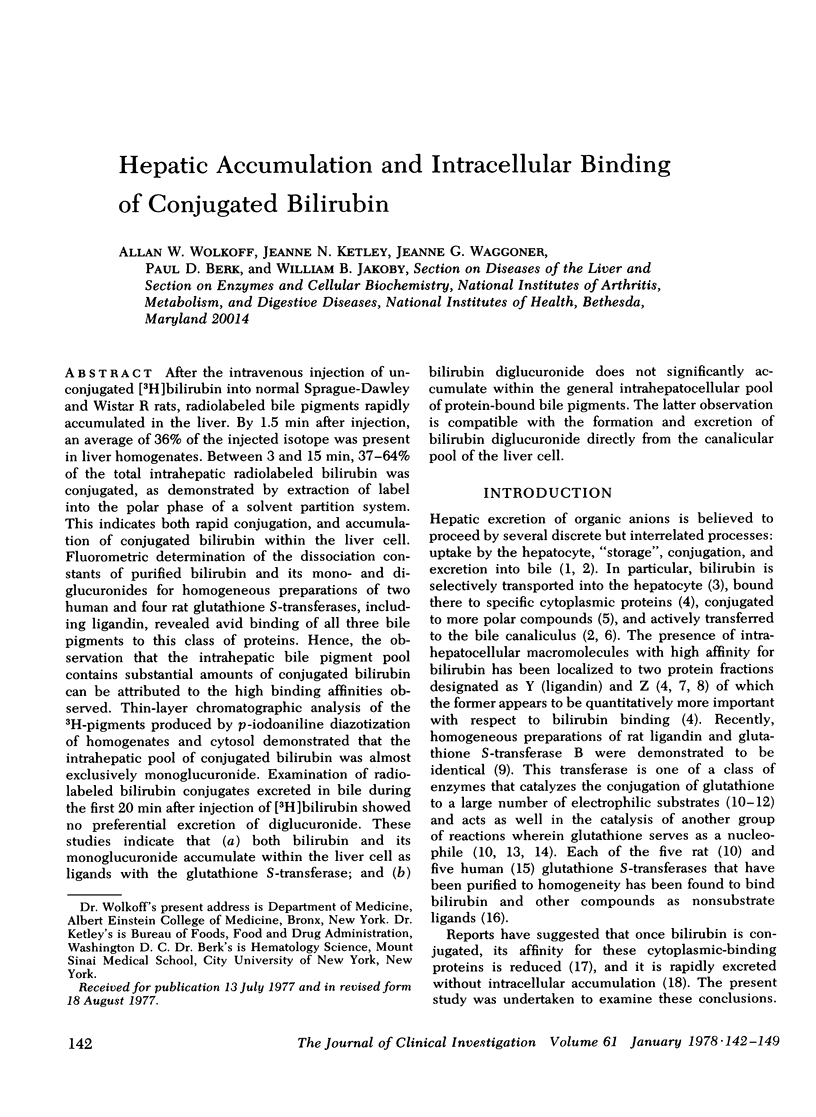
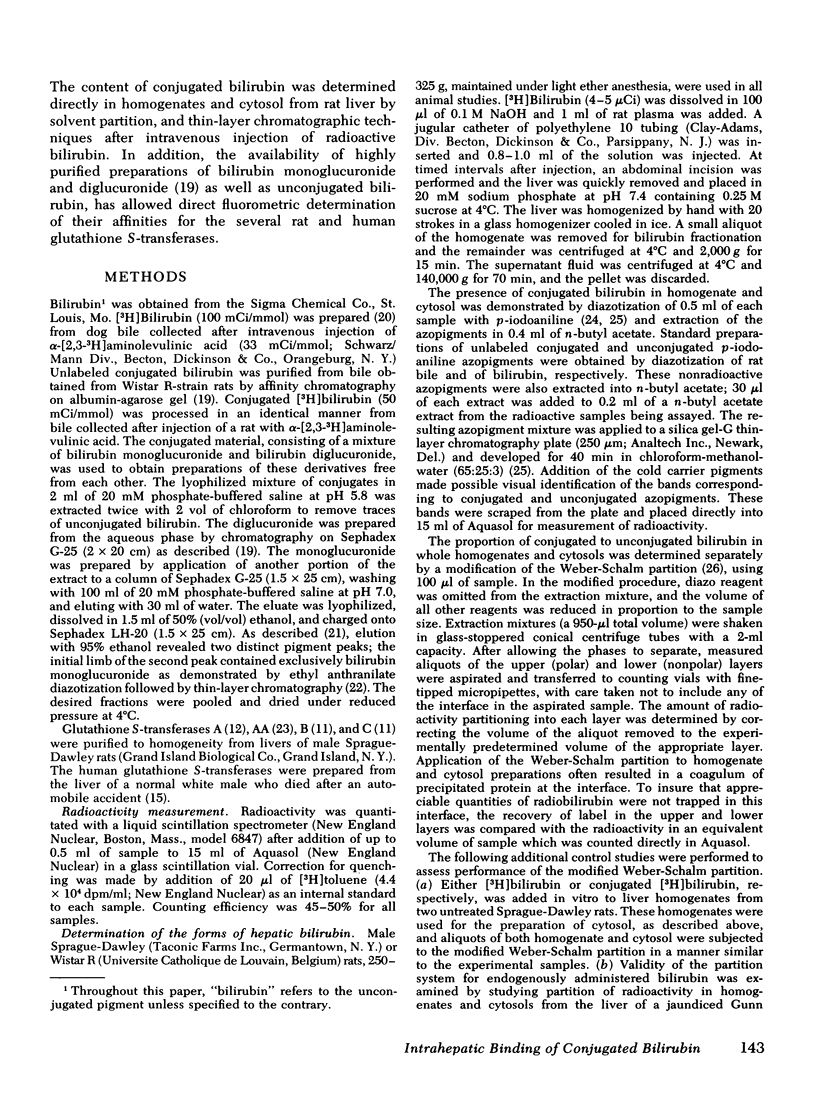
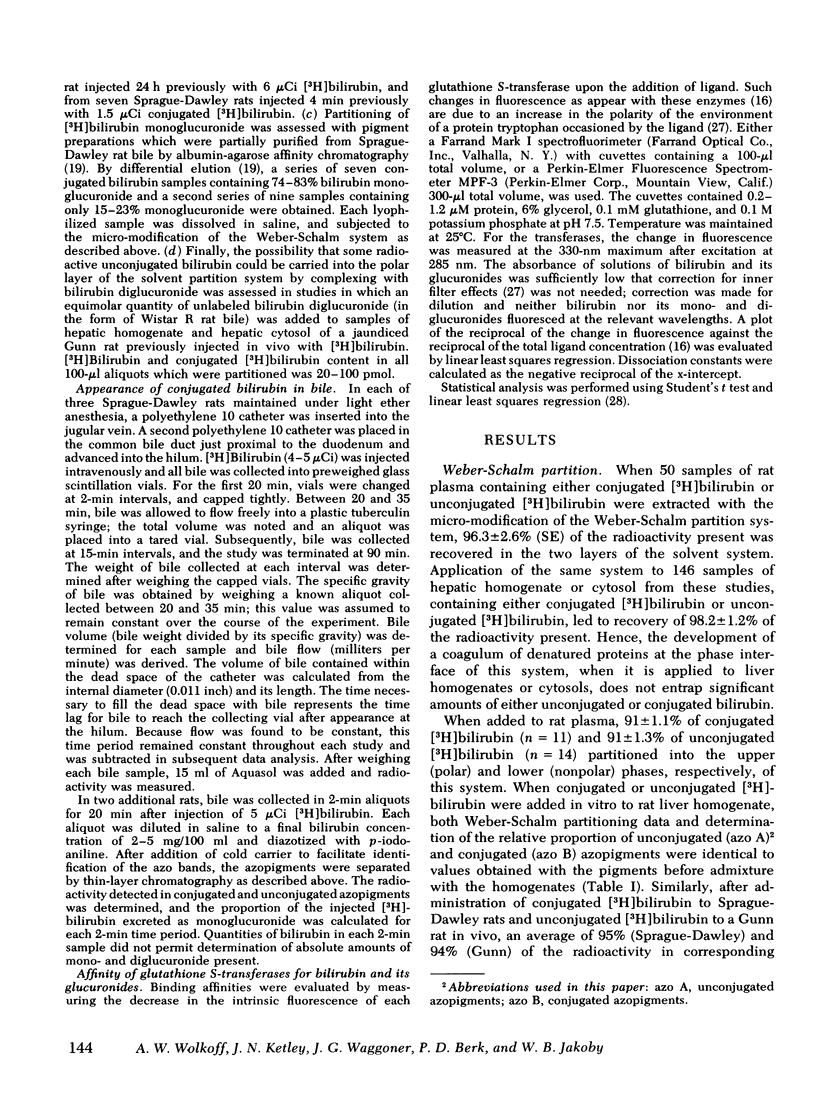
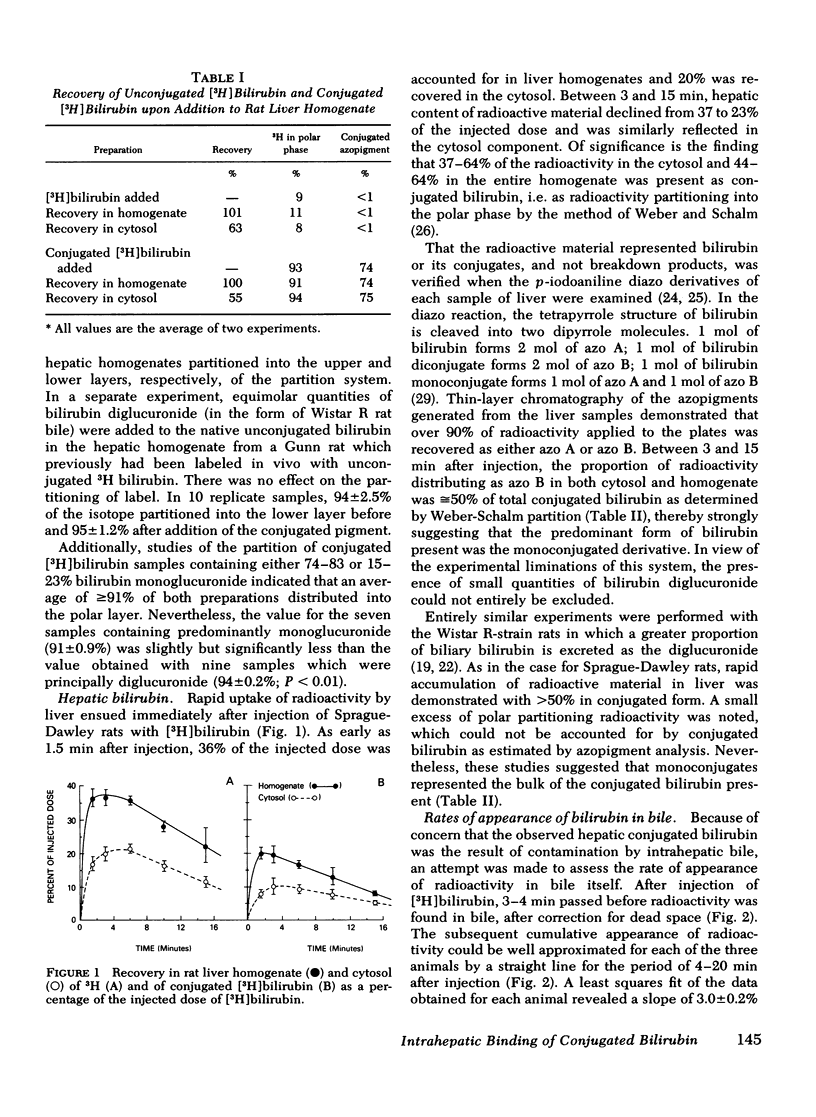
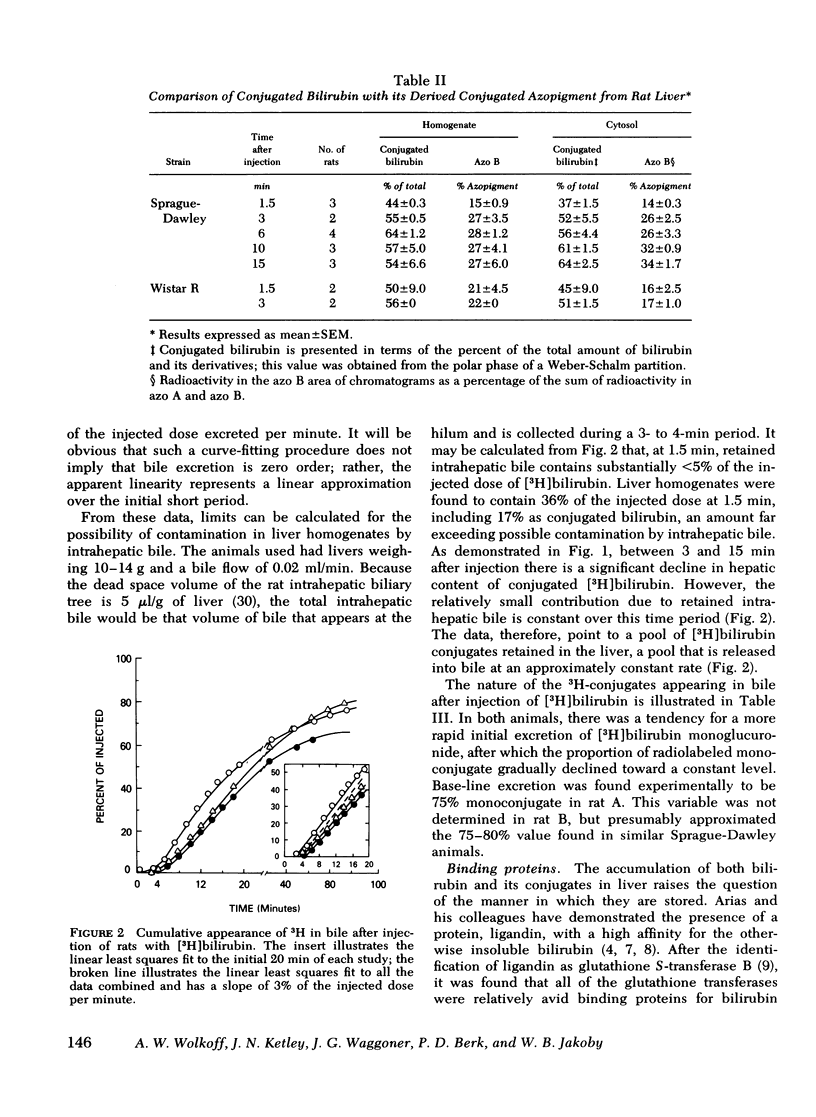
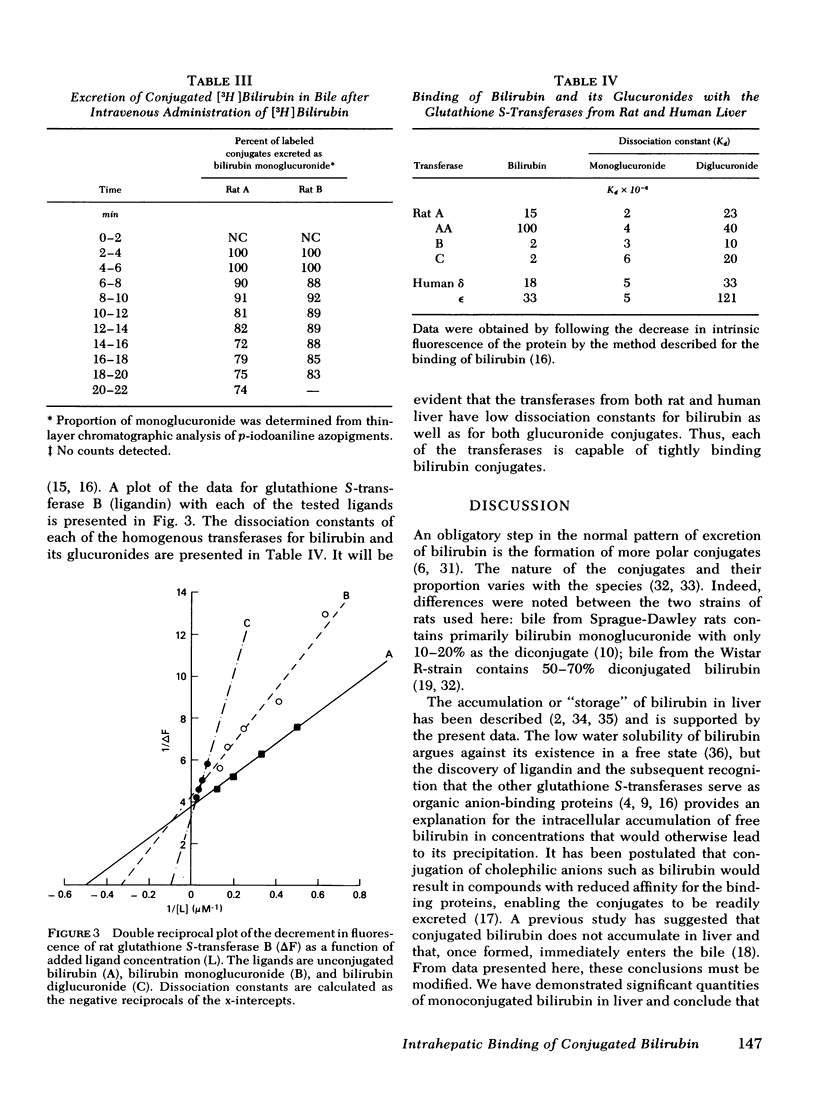
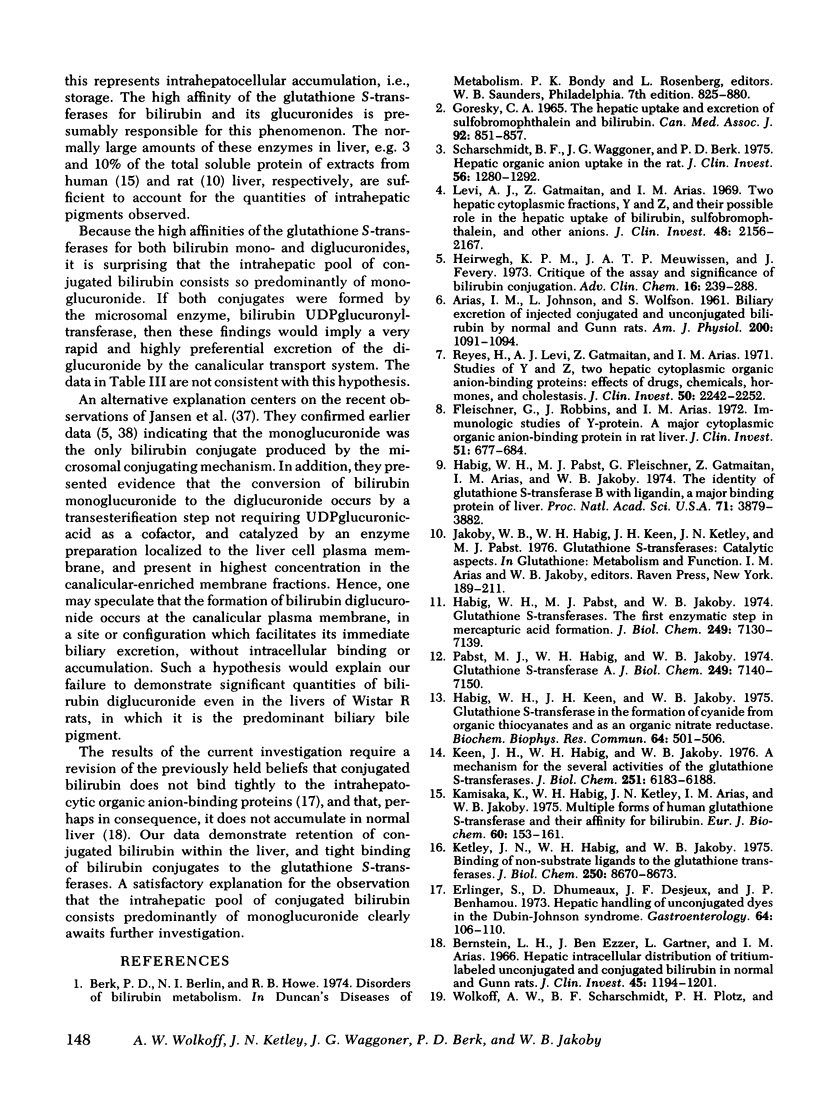
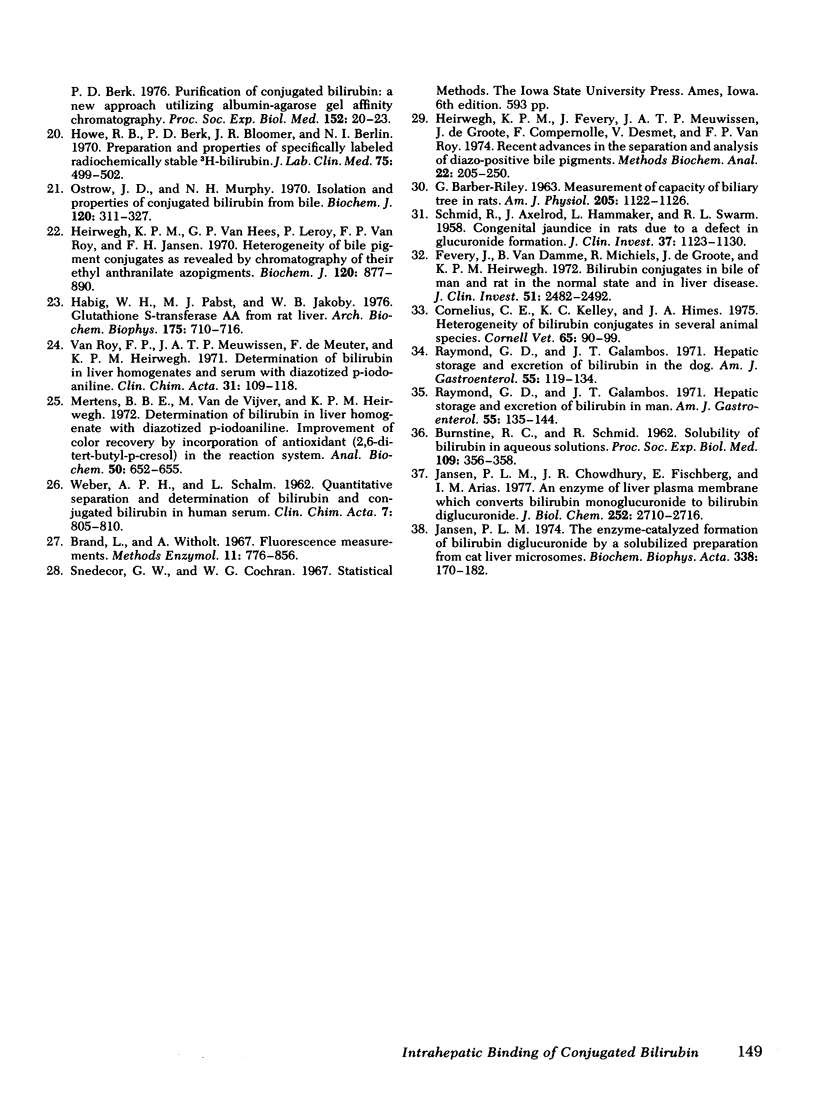
Selected References
These references are in PubMed. This may not be the complete list of references from this article.
- ARIAS I. M., JOHNSON L., WOLFSON S. Biliary excretion of injected conjugated and unconjugated bilirubin by normal and Gunn rats. Am J Physiol. 1961 May;200:1091–1094. doi: 10.1152/ajplegacy.1961.200.5.1091. [DOI] [PubMed] [Google Scholar]
- BARBER-RILEY G. MEASUREMENT OF CAPACITY OF BILIARY TREE IN RATS. Am J Physiol. 1963 Dec;205:1122–1126. doi: 10.1152/ajplegacy.1963.205.6.1122. [DOI] [PubMed] [Google Scholar]
- BURNSTINE R. C., SCHMID R. Solubility of bilirubin in aqueous solutions. Proc Soc Exp Biol Med. 1962 Feb;109:356–358. doi: 10.3181/00379727-109-27201. [DOI] [PubMed] [Google Scholar]
- Bernstein L. H., Ezzer J. B., Gartner L., Arias I. M. Hepatic intracellular distribution of tritium-labeled unconjugated and conjugated bilirubin in normal and Gunn rats. J Clin Invest. 1966 Jul;45(7):1194–1201. doi: 10.1172/JCI105425. [DOI] [PMC free article] [PubMed] [Google Scholar]
- Cornelius C. E., Kelley K. C., Himes J. A. Heterogeneity of bilirubin conjugates in several animal species. Cornell Vet. 1975 Jan;65(1):90–99. [PubMed] [Google Scholar]
- Erlinger S., Dhumeaux D., Desjeux J. F., Benhamou J. P. Hepatic handling of unconjugated dyes in the Dubin-Johnson syndrome. Gastroenterology. 1973 Jan;64(1):106–110. [PubMed] [Google Scholar]
- Fevery J., Van Damme B., Michiels R., De Groote J., Heirwegh K. P. Bilirubin conjugates in bile of man and rat in the normal state and in liver disease. J Clin Invest. 1972 Sep;51(9):2482–2492. doi: 10.1172/JCI107062. [DOI] [PMC free article] [PubMed] [Google Scholar]
- Fleischner G., Robbins J., Arias I. M. Immunological studies of Y protein. A major cytoplasmic organic anion-binding protein in rat liver. J Clin Invest. 1972 Mar;51(3):677–684. doi: 10.1172/JCI106856. [DOI] [PMC free article] [PubMed] [Google Scholar]
- GORESKY C. A. THE HEPATIC UPTAKE AND EXCRETION OF SULFOBROMOPHTHALEIN AND BILIRUBIN. Can Med Assoc J. 1965 Apr 17;92:851–857. [PMC free article] [PubMed] [Google Scholar]
- Galambos J. T., Raymond G. D. Hepatic storage and excretion of bilirubin in the dog. Am J Gastroenterol. 1971 Feb;55(2):119–134. [PubMed] [Google Scholar]
- Habig W. H., Keen J. H., Jakoby W. B. Glutathione S-transferase in the formation of cyanide from organic thiocyantes and as an organic nitrate reductase. Biochem Biophys Res Commun. 1975 May 19;64(2):501–506. doi: 10.1016/0006-291x(75)90349-6. [DOI] [PubMed] [Google Scholar]
- Habig W. H., Pabst M. J., Fleischner G., Gatmaitan Z., Arias I. M., Jakoby W. B. The identity of glutathione S-transferase B with ligandin, a major binding protein of liver. Proc Natl Acad Sci U S A. 1974 Oct;71(10):3879–3882. doi: 10.1073/pnas.71.10.3879. [DOI] [PMC free article] [PubMed] [Google Scholar]
- Habig W. H., Pabst M. J., Jakoby W. B. Glutathione S-transferase AA from rat liver. Arch Biochem Biophys. 1976 Aug;175(2):710–716. doi: 10.1016/0003-9861(76)90563-4. [DOI] [PubMed] [Google Scholar]
- Habig W. H., Pabst M. J., Jakoby W. B. Glutathione S-transferases. The first enzymatic step in mercapturic acid formation. J Biol Chem. 1974 Nov 25;249(22):7130–7139. [PubMed] [Google Scholar]
- Heirwegh K. P., Fevery J., Meuwissen J. A., De Groote J., Compernolle F., Desmet V., Van Roy F. P. Recent advances in the separation and analysis of diazo-positive bile pigments. Methods Biochem Anal. 1974;22:205–250. doi: 10.1002/9780470110423.ch5. [DOI] [PubMed] [Google Scholar]
- Heirwegh K. P., Meuwissen J. A., Fevery J. Critique of the assay and significance of bilirubin conjugation. Adv Clin Chem. 1973;16:239–288. doi: 10.1016/s0065-2423(08)60347-9. [DOI] [PubMed] [Google Scholar]
- Heirwegh K. P., Van Hees G. P., Leroy P., Van Roy F. P., Jansen F. H. Heterogeneity of bile pigment conjugates as revealed by chromatography of their ethyl anthranilate azopigments. Biochem J. 1970 Dec;120(4):877–890. doi: 10.1042/bj1200877. [DOI] [PMC free article] [PubMed] [Google Scholar]
- Howe R. B., Berk P. D., Bloomer J. R., Berlin N. I. Preparation and properties of specifically labeled radiochemically stable 3H-bilirubin. J Lab Clin Med. 1970 Mar;75(3):499–502. [PubMed] [Google Scholar]
- Jansen P. L., Chowdhury J. R., Fischberg E. B., Arias I. M. Enzymatic conversion of bilirubin monoglucuronide to diglucuronide by rat liver plasma membranes. J Biol Chem. 1977 Apr 25;252(8):2710–2716. [PubMed] [Google Scholar]
- Kamisaka K., Habig W. H., Ketley J. N., Arias M., Jakoby W. B. Multiple forms of human glutathione S-transferase and their affinity for bilirubin. Eur J Biochem. 1975 Dec 1;60(1):153–161. doi: 10.1111/j.1432-1033.1975.tb20987.x. [DOI] [PubMed] [Google Scholar]
- Keen J. H., Habig W. H., Jakoby W. B. Mechanism for the several activities of the glutathione S-transferases. J Biol Chem. 1976 Oct 25;251(20):6183–6188. [PubMed] [Google Scholar]
- Ketley J. N., Habig W. H., Jakoby W. B. Binding of nonsubstrate ligands to the glutathione S-transferases. J Biol Chem. 1975 Nov 25;250(22):8670–8673. [PubMed] [Google Scholar]
- Levi A. J., Gatmaitan Z., Arias I. M. Two hepatic cytoplasmic protein fractions, Y and Z, and their possible role in the hepatic uptake of bilirubin, sulfobromophthalein, and other anions. J Clin Invest. 1969 Nov;48(11):2156–2167. doi: 10.1172/JCI106182. [DOI] [PMC free article] [PubMed] [Google Scholar]
- Mertens B. B., Van de Vijver M., Heirwegh K. P. Determination of bilirubin in liver homogenate with diazotized p-iodoaniline. Improvement of color recovery by incorporation of antioxidant (2,6-di-tert-butyl-p-cresol) in the reaction system. Anal Biochem. 1972 Dec;50(2):652–655. doi: 10.1016/0003-2697(72)90080-2. [DOI] [PubMed] [Google Scholar]
- Ostrow J. D., Murphy N. H. Isolation and properties of conjugated bilirubin from bile. Biochem J. 1970 Nov;120(2):311–327. doi: 10.1042/bj1200311. [DOI] [PMC free article] [PubMed] [Google Scholar]
- Pabst M. J., Habig W. H., Jakoby W. B. Glutathione S-transferase A. A novel kinetic mechanism in which the major reaction pathway depends on substrate concentration. J Biol Chem. 1974 Nov 25;249(22):7140–7147. [PubMed] [Google Scholar]
- Raymond G. D., Galambos J. T. Hepatic storage and excretion of bilirubin in man. Am J Gastroenterol. 1971 Feb;55(2):135–144. [PubMed] [Google Scholar]
- Reyes H., Levi A. J., Gatmaitan Z., Arias I. M. Studies of Y and Z, two hepatic cytoplasmic organic anion-binding proteins: effect of drugs, chemicals, hormones, and cholestasis. J Clin Invest. 1971 Nov;50(11):2242–2252. doi: 10.1172/JCI106721. [DOI] [PMC free article] [PubMed] [Google Scholar]
- SCHMID R., AXELROD J., HAMMAKER L., SWARM R. L. Congenital jaundice in rats, due to a defect in glucuronide formation. J Clin Invest. 1958 Aug;37(8):1123–1130. doi: 10.1172/JCI103702. [DOI] [PMC free article] [PubMed] [Google Scholar]
- Scharschmidt B. F., Waggoner J. G., Berk P. D. Hepatic organic anion uptake in the rat. J Clin Invest. 1975 Nov;56(5):1280–1292. doi: 10.1172/JCI108204. [DOI] [PMC free article] [PubMed] [Google Scholar]
- Van Roy F. P., Meuwissen J. A., De Meuter F., Heirwegh K. P. Determination of bilirubin in liver homogenates and serum with diazotized p-iodoaniline. Clin Chim Acta. 1971 Jan;31(1):109–118. doi: 10.1016/0009-8981(71)90367-6. [DOI] [PubMed] [Google Scholar]
- WEBER A. P., SCHALM L. Quantitative separation and determination of bilirubin and conjugated bilirubin in human serum. Clin Chim Acta. 1962 Nov;7:805–810. doi: 10.1016/0009-8981(62)90063-3. [DOI] [PubMed] [Google Scholar]
- Wolkoff A. W., Scharschmidt B. F., Plotz P. H., Berk P. D. Purification of conjugated bilirubin: a new approach utilizing albumin-agarose gel affinity chromatography. Proc Soc Exp Biol Med. 1976 May;152(1):20–23. doi: 10.3181/00379727-152-39318. [DOI] [PubMed] [Google Scholar]


